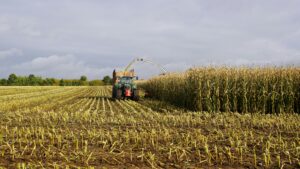Accurate emission data is considered vital for effective sustainability strategies yet corporates face major challenges in getting dependable information about Scope 3 emissions. Many companies face fragmentation of supply chains coupled with inconsistent reporting and the lack of verifiable metrics to facilitate accurate Scope 3 data collection. The need for real-time, automated, and scalable data collection solutions is greater than at any other time. This article explores how remote sensing improves the accuracy of Scope 3 data. It will also discuss the integration of remote sensing in corporate sustainability frameworks and will describe innovative applications that will drive emissions tracking in years ahead.
Harnessing Remote Sensing for Accurate Scope 3 Data Collection & Insights
Remote sensing technologies have changed the way organizations monitor emissions. It delivers accurate data that requires minimal manual reporting. Companies can attain high-precision activity-based supply chain monitoring through a combination of geospatial intelligence with an AI-based analysis. This section describes contextual aspects of remote sensing in Scope 3 data collection, such as its technique, its use, and its impact on emission monitoring:
Advanced Satellite Imaging for Supply Chain Emissions
Satellites can collect information on emissions from industrial and deforestation activities, as well as transport systems. Monitoring the value chain via high-resolution imagery allows companies to pinpoint hotspots of emissions and locate potential for improvement within all of their operations. The embedding of AI-based analytics turns the satellite data into useful information, which can be used by corporate AI systems. The procedure ensures enhanced accuracy for reporting data without neglecting all mandated regulatory needs. Spectral imaging integration also enables the observation of methane leakage and land use changes resulting in carbon footprint. So, satellites provide the benefit of being able to monitor at a global level and remain comprehensive.
IoT Sensor Networks for Real-Time Data Acquisition
IoT Sensors used at key stages such as production facilities or transport nodes along the supply chain continuously provide emission readings. The sensors generate comprehensive data about fuel usage, industrial manufacturing output as well as greenhouse gas records at granular levels. Moreover, real-time cloud transmission enables companies to gain awareness, make accurate emission predictions/ sustainable data-driven decisions, and develop a better understanding of their entire Scope 3 footprint. Continuous monitoring also reduces the need to use stand-alone time point surveys. This increases the accuracy of the scope 3 data collection results and ensures compliance with the emerging regulatory requirements.
UAVs and Drones for On-Site Carbon Tracking
Drones equipped with emission-detecting sensors provide a budget-friendly solution for environmental impact assessment of locations that would otherwise be inaccessible to traditional assessment. Industries like agriculture and logistics benefit from this kind of surveillance to track emissions. This is from land use, deforestation, and vehicle exhaust. This data also supplements satellite imagery, allowing for a more comprehensive profile of emissions for organizations. Additionally, drones are very useful for the monitoring of short-term emission bursts that allow the industry to respond proactively to new sustainability problems.
AI and Machine Learning for Data Interpretation
AI-based analytics simplify the analysis of vast remote sensing datasets. Furthermore, ML identifies patterns in emission sources, associates them with changes in operations, and develops optimized mitigation measures. This also leads to more accurate carbon footprint quantification and improvement in the quality, relevance, and usefulness of Scope 3 reporting. AI is also applicable to anomaly detection. It indicates any anomaly in emissions data that is indicative of leaks, inefficiencies, or underreporting of sources.
Scope 3 Data Collection: Integrating Remote Sensing with Corporate Sustainability Strategies
Remote sensing must be integrated into an organization’s sustainability efforts to unlock its full potential. In this part, the contribution of remote sensing to corporate sustainability planning and the practical utilization of remote sensing for Scope 3 emissions tracking is emphasized:
Enhancing Supplier Accountability through Transparent Monitoring
Remote sensing allows organizations to track supplier emissions thereby helping ensure compliance with sustainability measures. Companies can use satellite-based measurements of emission levels to contact their suppliers about environmental action. This paves the way for both integration in carbon footprint reduction initiatives, and improvement in the quality of the reporting of Scope 3 exposure. Supplier transparency initiatives made possible by remote sensing data can also be used by firms to implement sustainability-linked contractual commitments.
Improving Carbon Footprint Calculations with High-Precision Data
Traditional Scope 3 calculations are based on broad emission factors, often making them inaccurate. Remote sensing introduces precise, location-based data, refining emission assessments. Moreover, with geospatial analytics, companies are finally moving beyond estimates and can get a direct quantification and this is likely to contribute to better sustainability reporting. Investors also reduce the risk of greenwashing allegations. This ensures that their emissions claims are from traceable sources.
Supporting Climate Risk Management and Adaptation
Apart from emission monitoring, remote sensing can help organizations decide on climate change implications for supply chains. Using the tracking of environmental dynamics such as forest loss, floods, and extreme weather, it is possible to adjust procurement strategies and enhance supply chain robustness. This proactive approach ensures sustainable operations in a rapidly changing climate. Remote sensing can also be used to organize early-warning systems for disaster-prone supply chains. This allows businesses to quickly change gears when disruption occurs.
Meeting Regulatory Requirements with Verifiable Data
As regulatory emphasis on Scope 3 emissions increases, remote sensing presents the verifiable data to meet that demand. Automated reporting tools generate reliable, tamper-proof evidence (aligning with frameworks like CSRD and SBTi). This therefore enhances the corporate sustainability reputation and minimizes the risk of penalties. So, organizations using remote sensing within their compliance plans will have a competitive advantage in showing compliance with the most demanding sustainability regulations.
Future Prospects: Scaling Remote Sensing for Scope 3 Data Collection & Analysis
Remote sensing adoption will continue to increase with technological advances and corporate sustainability requirements. Scaling these solutions through the supply chain in any sector will offer new opportunities to both reduce emissions and optimize supply chains. This subsection discusses the future evolution of remote sensing for Scope 3 data collection and its wider contribution:
Expanding Global Data Networks for Cross-Sector Analysis
Interconnected data networks will allow industries to share insights into emissions more effectively. Furthermore, with cross-sector remote sensing data, businesses will be able to collaborate on emission reduction strategies. This uses industry-wide benchmarks to improve efforts on sustainability. These data networks will also offer a standard way of reporting for Scope 3. This will lead to reliable and useful comparisons of supply chains globally.
AI-Driven Predictive Analytics for Emission Forecasting
The use of AI-based forecasting prediction models leads to an emission revolution that allows companies to act proactively for sustainability purposes. The study of remote sensing patterns allows businesses to determine potential emission triggers through which they can implement preventive measures. This forward-thinking approach will change how companies handle Scope 3 emissions and speed up their journey to net-zero goals. These prediction models will also let organizations plan for different scenarios allowing them to study the long-term effects of various sustainability efforts.
Remote Sensing Integration with Digital Twins for Emission Optimization
With remote sensing technology, companies can establish virtual supply chains using digital twins for conducting emission reduction testing of their multiple strategic options. The testing of possible scenarios through this approach allows organizations to calibrate their logistics systems. It also allows calibration of supplier relations, and production networks for reducing carbon emissions. Additionally, digital twins will allow companies to develop highly interactive and practical means. It will assess the impact of sustainability interventions at a large scale before their actual implementation in practice.
Quantum Computing for Complex Emission Data Processing
Quantum computing technology will strengthen the amount of computational processing power accessible for scope 3 data collection & analysis. These algorithms will allow organizations to handle vast remote sensing datasets at unprecedented speeds. It will also help to identify earlier undetectable emission patterns. Using this technological advancement companies can improve both tracking precision and efficiency for Scope 3 emission data thus enabling them to build advanced sustainability initiatives.
To Sum Up
Remote sensing technology is changing scope 3 data collection. It offers precise real-time data about emissions across the whole value chain. The incorporation of remote sensing into sustainability strategies improves supplier accountability systems, maintains regulatory standards, and reduces organizational risks. Additionally, remote sensing technology is expected to expand its capabilities with advancing technology and subsequently enhance the precision of emission reporting under Scope 3 standards.
The upcoming 3rd Annual Scope 3 Summit scheduled for March 13-14, 2025, in Berlin, Germany offers industry leaders a chance to obtain a detailed understanding of managing Scope 3. The conference will explore advanced technologies, regulatory updates, and proven practices regarding emissions control. So, seize your spot now!




